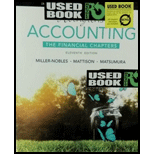
Concept explainers
1)
Introduction:
Contribution Margin:
- Contribution Margin refers to the excess of Sales revenues over variable and fixed costs. Since it contributes to the overall profitability of the business it is referred to as contribution margin.
- Variable costs refer to the costs of manufacture that have a direct co-relation with the volume of the goods manufactured, i.e. the costs increase with an increase in the goods produced. Examples are costs of direct material and direct labor.
- Fixed costs refer to the costs of manufacture that have an inverse co-relation with the volume of the goods manufactured, i.e. the costs decrease with an increase in the goods produced. Examples are costs of factory rent, depreciation on plant and equipment
Breakeven Point:
• Breakeven point is the monetary value of sales or number of units of sales where the contribution equals the fixed costs and the
• Breakeven point is considered as the minimum sales needed to sustain a business without incurring losses.
a) Breakeven point with no change in information
b) Breakeven point with $250 reduced sales price
c) Breakeven point with $100 reduced variable costs
d) Breakeven point with $122,500 of fixed costs
2)
Introduction:
Contribution Margin:
- Contribution Margin refers to the excess of Sales revenues over variable and fixed costs. Since it contributes to the overall profitability of the business it is referred to as contribution margin.
- Variable costs refer to the costs of manufacture that have a direct co-relation with the volume of the goods manufactured, i.e. the costs increase with an increase in the goods produced. Examples are costs of direct material and direct labor.
- Fixed costs refer to the costs of manufacture that have an inverse co-relation with the volume of the goods manufactured, i.e. the costs decrease with an increase in the goods produced. Examples are costs of factory rent, depreciation on plant and equipment
Breakeven Point:
• Breakeven point is the monetary value of sales or number of units of sales where the contribution equals the fixed costs and the profit / loss is zero.
• Breakeven point is considered as the minimum sales needed to sustain a business without incurring losses.
Sensitivity Analysis:
• Sensitivity Analysis is a study of the proportionate changes in the output of a calculation in response to a corresponding change in the inputs of the calculation.
• For instance, if contribution margin and breakeven point are analyzed, the changes in contribution margin and breakeven point corresponding to changes in the values of sales price, variable costs and fixed costs would be studied under sensitivity analysis.
• The objective of sensitivity analysis is to determine which factor of input has the greatest impact on the output and use appropriate controls to track and monitor such inputs.
• Impact of $250 reduced sales price on Contribution Margin and Breakeven point
• Impact of $100 reduced variable costs on Contribution Margin and Breakeven point
• Impact of $122,500 of fixed costs on Contribution Margin and Breakeven point
Want to see the full answer?
Check out a sample textbook solution
Chapter 21 Solutions
Horngren's Accounting, The Financial Chapters (11th Edition) - Standalone Book
- Bruno Manufacturing uses direct labor-hours in its predetermined overhead rate. At the beginning of the year, the total estimated manufacturing overhead was $680,000. At the end of the year, actual direct labor-hours for the year were 42,500 hours, manufacturing overhead for the year was underapplied by $25,500, and the actual manufacturing overhead was $695,000. The predetermined overhead rate for the year must have been closest to: A) $16.00 B) $15.75 C) $16.35 D) $16.94arrow_forwardWhat was manufactured overhead?arrow_forwardWhich of the following choices is the correct status of manufacturing overhead at year-end?arrow_forward
- Morris Corporation applies manufacturing overhead at the rate of $40 per machine hour. Budgeted machine hours for the current period were anticipated to be 200,000; however, higher than expected production resulted in actual machine hours worked of 225,000. Budgeted and actual manufacturing overhead figures for the year were $8,000,000 and $8,750,000, respectively. On the basis of this information, the company's year-end overhead was: A. overapplied by $250,000 B. underapplied by $250,000 C. overapplied by $750,000 D. underapplied by $750,000arrow_forwardAt the beginning of the year, manufacturing overhead for the year was estimated to be $560,000. At the end of the year, actual labor hours for the year were 35,000 hours, the actual manufacturing overhead for the year was $590,000, and the manufacturing overhead for the year was underapplied by $30,000. If the predetermined overhead rate is based on direct labor hours, then the estimated labor hours at the beginning of the year used in the predetermined overhead rate must have been ___ hours.arrow_forwardGive me Answerarrow_forward

 AccountingAccountingISBN:9781337272094Author:WARREN, Carl S., Reeve, James M., Duchac, Jonathan E.Publisher:Cengage Learning,
AccountingAccountingISBN:9781337272094Author:WARREN, Carl S., Reeve, James M., Duchac, Jonathan E.Publisher:Cengage Learning, Accounting Information SystemsAccountingISBN:9781337619202Author:Hall, James A.Publisher:Cengage Learning,
Accounting Information SystemsAccountingISBN:9781337619202Author:Hall, James A.Publisher:Cengage Learning, Horngren's Cost Accounting: A Managerial Emphasis...AccountingISBN:9780134475585Author:Srikant M. Datar, Madhav V. RajanPublisher:PEARSON
Horngren's Cost Accounting: A Managerial Emphasis...AccountingISBN:9780134475585Author:Srikant M. Datar, Madhav V. RajanPublisher:PEARSON Intermediate AccountingAccountingISBN:9781259722660Author:J. David Spiceland, Mark W. Nelson, Wayne M ThomasPublisher:McGraw-Hill Education
Intermediate AccountingAccountingISBN:9781259722660Author:J. David Spiceland, Mark W. Nelson, Wayne M ThomasPublisher:McGraw-Hill Education Financial and Managerial AccountingAccountingISBN:9781259726705Author:John J Wild, Ken W. Shaw, Barbara Chiappetta Fundamental Accounting PrinciplesPublisher:McGraw-Hill Education
Financial and Managerial AccountingAccountingISBN:9781259726705Author:John J Wild, Ken W. Shaw, Barbara Chiappetta Fundamental Accounting PrinciplesPublisher:McGraw-Hill Education





